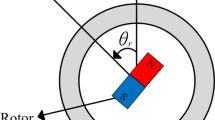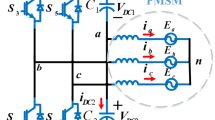Abstract
The aim of this paper is to present a new method to generate stator currents supplying a surface permanent magnets synchronous motor (SPMSM) presenting an asymmetry of the stator windings. This asymmetry may be due to a lack of turns in one of the stator windings or to an inter-turns short circuit. An analytical model of the SPMSM is developed to calculate the current which allows minimizing the torque ripple generated by the asymmetry. This model is based on the combination of the space harmonics of the flux densities of stator and rotor for the generation of the torque. Our study leads to define a stator inverse current system able to compensate the harmonic torque component at the double of the supply frequency. In the experimental tests, several cases of supply were applied and the results confirmed those obtained by the analytical study essentially concerning the amplitude of the inverse current.


















Similar content being viewed by others
Abbreviations
- \({\alpha }^\mathrm{s}\) (rad):
-
Angular abscissa of the point M, related to the stator reference axis
- \({\alpha }^\mathrm{r}\) (rad):
-
Angular abscissa of the point M, related to the rotor reference axis
- \({\beta }_{j}^\mathrm{s} \) (rad):
-
Angular position of the stator slot j
- \(\varGamma _{h}\) :
-
Coefficient linked to the linear evolution of the mmf along the slot width
- \({\delta }\) (m):
-
Half slot width \({\delta }=(1-{r}_\mathrm{d}^\mathrm{s} ){\pi }/{N}_\mathrm{t}^\mathrm{s}\)
- \({\varepsilon }_{j}^\mathrm{s}\) (A):
-
Magnetomotive force created by conductors contained in the slot j
- \({\varepsilon }^\mathrm{s} \) (A):
-
Total magnetomotive force generated by all slots
- \({\theta }\) (rad):
-
Rotor position related to the stator reference axis
- \({\mu }_{0} \) (H/m):
-
Vacuum permeability
- \(\varphi _{j} \) (rad):
-
Current phase angle in the slot j
- \(\varphi _{n}^\mathrm{r} \) (rad):
-
Phase of the rotor flux density space harmonic relating to the fundamental
- \(\varphi _{h}^\mathrm{s} \) (rad):
-
Phase of the stator flux density space harmonic relating to the fundamental
- \({\omega }\) (rad/s):
-
Supply angular frequency
- \({b}^\mathrm{s}\) (T):
-
Stator flux density
- \({b}^\mathrm{r}\) (T):
-
Rotor flux density
- e (m):
-
Minimum air gap thickness
- h :
-
mmf space harmonic rank
- \({i}_{j}^\mathrm{s} \) (A):
-
Current flowing in the conductors of slot j
- \({k}_\mathrm{s}\) :
-
Permeance rank
- K :
-
Ratio of faulty turn in one slot
- \({l}_{e}^\mathrm{s} \) (m):
-
Stator slot width
- \({l}_\mathrm{d}^\mathrm{s} \) (m):
-
Stator tooth width
- \({\hbox {mmf}}\) :
-
Magnetomotive force
- \({N}_\mathrm{t}^\mathrm{s}\) :
-
Total stator slot number
- \({n}_{e}\) :
-
Number of conductors in stator slot
- \({n}_{{j\mathrm{def}}}^{e}\) :
-
Conductors number in faulty slot j
- p :
-
Pole pair number
- P (H):
-
Air gap permeance
- \({p}^\mathrm{s}\) (m):
-
Stator fictive slot depth
- \({R}_\mathrm{s} \) (m):
-
Stator inner radius
- \({r}_\mathrm{d}^\mathrm{s}\) :
-
Stator toothing ratio \({r}_\mathrm{d}^\mathrm{s} =\frac{{l}_\mathrm{d}^\mathrm{s} }{{l}_\mathrm{d}^\mathrm{s} +{l}_{e}^\mathrm{s}}\)
- \({V}\,({\hbox {m}}^{3})\) :
-
Total volume of the air gap
- \(W_\mathrm{mag}\) (J):
-
Magnetic co-energy
References
Li S, Xia C, Zhou X (2012) Disturbance rejection control method for permanent magnet synchronous motor speed-regulation system. Mechatronics 22:706–714
Borghi CA, Casadei D, Fabbri M, Serra G (1998) Reduction of the torque ripple in permanent magnet actuators by a multi-objective minimization technique. IEEE Trans Magnetics 34:2869–2872
Mohamed YA-RI, Newly A (2007) Designed instantaneous-torque control of direct-drive PMSM servo actuator with improved torque estimation and control characteristics. IEEE Trans Ind Electron 54:2864–2873
Pellegrino G, Guglielmi P, Vagati A, Villata F (2010) Core losses and torque ripple in IPM machines: dedicated modeling and design tradeoff. IEEE Trans Ind Appl 46:2381–2391
Mademlis C, Margaris N (2002) Loss minimization in vector-controlled interior permanent-magnet synchronous motor drives. IEEE Trans Ind Electron 49:1344–1347
Ebrahimi BM, Faiz J (2012) Configuration impact on eccentricity fault detection in permanent magnet synchronous motors. IEEE Trans Magnetics 48:903–906
Ebrahimi BM, Roshtkhari MJ, Faiz J, Khatami SV (2014) Advanced eccentricity fault recognition in permanent magnet synchronous motors using stator current signature analysis. IEEE Trans Ind Electron 61:2041–2052
Byong IJ, Hyon J, Nam K (2013) Dynamic modeling and control for SPMSMs with internal turn short fault. IEEE Trans Power Electron 28:3495–3508
Urresty JC, Atashkhooei R, Riba JR, Romeral L, Royo S (2013) Shaft trajectory analysis in a partially demagnetized permanent-magnet synchronous motor. IEEE Trans Ind Electron 60:3454–3461
Brudny JF, Lecointe JP (2011) Rotor design for reducing the switching magnetic noise of ac electrical machine variable-speed drives. IEEE Trans Ind Electron 58:5112–5120
Leboeuf N, Boileau T, Nahid-Mabarakeh B, Takorabet N, Meibody-Tabar F, Clerc G (2012) Inductance calculations in permanent-magnet motors under fault conditions. IEEE Trans Magnetics 48:2605–2616
Romeral L, Urresty JC, Ruiz JR, Espinosa AG (2011) Modeling of surface-mounted permanent magnet synchronous motors with stator winding interturn faults. IEEE Trans Ind Electron 58:1576–1585
Xu JX, Panda SK, Pan YJ, Lee TH, Lam BH (2004) A modular control scheme for PMSM speed control with pulsating torque minimization. IEEE Trans Ind Electron 51:526–536
Ait-Gougam Y, Ibtiouen R, Touhami O, Louis J-P, Gabsi M (2008) Inverse modeling and pulsating torque minimization of salient pole non-sinusoidal synchronous machines. Electr Power Syst Res 78:88–96
Hasanien HM (2010) Torque ripple minimization of permanent magnet synchronous motor using digital observer controller. Energy Convers Manag 51:98–104
N’diaye A, Espanet C, Miraoui A (2004) Reduction of the torque ripples in brushless PM motors by optimization of the supply—theoretical method and experimental implementation. In IEEE international symposium on industrial electronics, Ajaccio, France 2–4 May, vol 2, pp 1345–1350
Hung JY, Ding Z (1993) Design of currents to reduce torque ripple in brushless permanent magnet motors. IEE Proc B Electr Power Appl 140(4):260–266
Favre E, Cardoletti L, Jufer M (1993) Permanent-magnet synchronous motors: a comprehensive approach to cogging torque suppression. IEEE Trans Ind Appl 29:1141–1149
Jia H, Cheng M, Hua W, Zhao W, Li W (2010) Torque ripple suppression in flux-switching PM motor by harmonic current injection based on voltage space-vector modulation. IEEE Trans Magnetics 46:1527–1530
Lee GH, Kim SI, Hong JP, Bahn JH (2008) Torque ripple reduction of interior permanent magnet synchronous motor using harmonic injected current. IEEE Trans Magnetics 44:1582–1585
Holtz J, Springob L (1996) Identification and compensation of torque ripple in high-precision permanent magnet motor drives. IEEE Trans Ind Electron 43:309–320
Kestelyn X, Semail E (2011) A Vectorial Approach for generation of optimal current references for multiphase permanent-magnet synchronous machines in real time. IEEE Trans Ind Electron 58:5057–5065
Bennett JW, Jack AG, Mecrow BC, Atkinson DJ, Sewell C, Mason G (2004) Fault-tolerant control architecture for an electrical actuator. In: 35th annual IEEE power electronics specialists conference, Aachen, Gemany 20–25 June, pp 4371–4371
Cintron-Rivera JG, Foste SN, Strangas EG (2015) Mitigation of turn-to-turn faults in fault tolerant permanent magnet synchronous motors. IEEE Trans Energy Convers 30(2):465–475
Toda H, Xia Z, Wang J, Atallah K, Howe D (2004) Rotor Eddy current loss in permanent magnet brushless machines. IEEE Trans Magnetics 40:2104–2106
Dajaku G, Gerling D (2012) Air-gap flux density characteristics of salient pole synchronous permanent-magnet machines. IEEE Trans Magnetics 48:2196–2204
Bianchi N, Fornasiero E (2009) Impact of MMF space harmonic on rotor losses in fractional-slot permanent-magnet machines. IEEE Trans Energy Convers 24:323–328
Ko HS, Kim KJ (2004) Characterization of noise and vibration sources in interior permanent-magnet brushless DC motors. IEEE Trans Magnetics 40:3482–3489
Gaussens B, Hoang E, de la Barrière O, Saint-Michel J, Manfe P, Lécrivain M, Gabsi M (2013) Analytical armature reaction field prediction in field-excited flux-switching machines using an exact relative permeance function. IEEE Trans Magnetics 49:628–641
Zhu ZQ, Howe D (1992) Analytical prediction of the cogging torque in radial-field permanent magnet brushless motors. IEEE Trans Magnetics 28:1371–1374
Proca AB, Keyhani A, EL-Antably A, Dai WLM (2003) Analytical model for permanent magnet motors with surface mounted magnets. IEEE Trans Energy Convers 18:386–391
Simon-Sempere V, Burgos-Payan M, Cerquides-Bueno J-R (2012) Spatial filtering: a tool for selective harmonics elimination in the design of permanent-magnet synchronous motors. IEEE Trans Magnetics 48:2056–2067
Sun T, Kim JM, Lee GH, Hong JP, Choi MR (2011) Effect of pole and slot combination on noise and vibration in permanent magnet synchronous motor. IEEE Trans Magnetics 47:1038–1041
Author information
Authors and Affiliations
Corresponding author
Appendices
Appendix 1
Appendix 2
The strategy for calculation of stator currents consists in canceling the space harmonic of stator mmf of rank \(h = -p\) in the case of a stator fault in one phase winding. The computation of a mmf space harmonic component is done by considering the currents in each slot. The following developments consider a p pole pair machine with an inter-turn short-circuit fault that occurs in slots \({j}_{1}\) and \({j}_{2}\). K is the ratio of faulty windings in the faulty slots, and \({I}_{{a}1}\) is the rms value of the current in the faulty turns.
Let us consider the mmf \({\varepsilon }_{j}^\mathrm{s}\) generated by the \({n}^{{e}}\) wire placed in slot j. The waveform of \({\varepsilon }_{j}^\mathrm{s}\) is shown in Fig. 19.
\({\varepsilon }_{j}^\mathrm{s} \) can be written with a Fourier series as follows:
The analytical computation is performed using the complex notation of the mmf components when the SPMSM is assumed to be supplied with sine currents: \({i}_{j}^\mathrm{s} =\sqrt{{2}}{ I}_{j}^\mathrm{s} {\sin }(\omega {t}+{\varphi }_{j})\).
Then, the complex quantity \({\overline{\varepsilon }}_{{j},{h}}^\mathrm{s}\) is defined such that:
And the rank h of mmf harmonic generated by all the slots can be expressed as:
Case of inter-turn short-circuit fault in stator winding
The stator winding mmf at \(h=-p\) is computed in two cases:
-
healthy stator winding supplied by direct current of \({I}_\mathrm{d}\) rms value, in this case the mmf harmonic at \(h=-p\) is null, because in healthy case only the ranks \(h=p(6k+1)\) exist.
$$\begin{aligned} {\overline{\varepsilon }}_{{d}-{p}}^\mathrm{s} =\sum _{{j}=1}^{{N}_\mathrm{t}^\mathrm{s} } {\frac{{n}^{e} {I}_\mathrm{d}}{\sqrt{{2}}({\pi }-\delta )(-{p})}}{\varGamma }_{-{p}}\mathrm{e}^{{i}(-{p}{\beta }_{j}^\mathrm{s} +{\varphi }_{{dj}} )} =0\nonumber \\ \end{aligned}$$(15) -
faulty stator winding supplied by direct current of \({I}_\mathrm{d}\) rms value. In this case, \({Kn}^{{e}}\) wires of the slots \({j}_{1}\) an \({j}_{2}\) are flowed through by a current of \({I}_{{a}1}\) magnitude and the other wires of the both slots (\((1-{K}){n}^{{e}}\) wires) are flowed through by the line current of \({I}_{{d}}\) magnitude:
$$\begin{aligned} {\overline{\varepsilon }}_{{d},-{p}_{(\mathrm{fault})} }^\mathrm{s}= & {} {\mathop {\mathop {\sum }\limits ^{{N}_\mathrm{t}^\mathrm{s}}_{{j}=1}}\limits _ {{j}\ne {j}_{1} ,{j}_{2}}} \frac{{n}^{e} {I}_\mathrm{d}}{\sqrt{{2}}({\pi }-\delta )(-{p})}{\varGamma _{-{p}} \mathrm{e}^{{i}(-{p}{\beta }_{j}^\mathrm{s} + {\varphi }_{{dj}} )}} \nonumber \\&+\, \sum _{{j}={j}_{1} ,{j}_{2} } {\frac{{Kn}^{{e}}{I}_{{a}1} }{\sqrt{{2}}({\pi }-\delta )(-{p})}{\varGamma }_{-{p}} \mathrm{e}^{{i}(-{p}{\beta }_{j}^\mathrm{s} +{\varphi } _{{a1dj}} )}} \nonumber \\&+\,\sum _{{j}={j}_{1} ,{j}_{2}} {\frac{(1-{K}){n}^{{e}}{I}_\mathrm{d} }{\sqrt{{2}}({\pi } -\delta )(-{p})}}\varGamma _{-{p}} \mathrm{e}^{{i}(-{p}{\beta }_{j}^\mathrm{s} +{\varphi } _{{dj}} )}\nonumber \\ \end{aligned}$$(16)
For the stator winding supplied by inverse current of \({I}_{i}\) rms value, it is supposed that the inverse current does not flow through the fault resistance \({r}_{{f}}\), the stator winding mmf at \(h=-p\) can be expressed as follows:
To cancel the harmonic at \(h = -p\), the mmf generated by the inverse and direct current must satisfy the following equation:
Then it comes:
Replacing \({\varepsilon }_{{i},-{p}(\mathrm{fault})}^\mathrm{s}\) with (17), it comes:
Finally, after simplification, the relationship between the direct current and the inverse current used to compensate the harmonic of rank \(h=-p\) is given by:
And finally:
Rights and permissions
About this article
Cite this article
Bahri, E., Pusca, R., Romary, R. et al. A new approach for torque ripple reduction in a faulty surface permanent magnet synchronous motor by inverse current injection. Electr Eng 100, 565–579 (2018). https://doi.org/10.1007/s00202-017-0529-z
Received:
Accepted:
Published:
Issue Date:
DOI: https://doi.org/10.1007/s00202-017-0529-z





